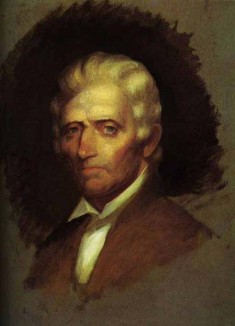Colonel Daniel Boone was an American explorer, solider, and pioneer. He is often called the most famous pioneer and frontier hero there ever was. He is especially known for his exploration of the wilderness of the state of Kentucky. In addition, he also served as a military officer during the Revolutionary War fought between American settlers and the British-aided military Americans.
Early Years
Daniel Boone was born in Pennsylvania on November 2, 1734, to a family of Quakers. He was the sixth of the eleven children born to Sarah and Squire Boone. His father, Squire, had emigrated from England to Pennsylvania and joined William Penn’s colony of dissenters. Squire worked as a weaver and a blacksmith.
During his early years, Daniel helped his father at his farm, and he spent much of his time hunting and trapping. He loved wandering the woods with the cows. His father gave him his first rifle when he was twelve years old.
Self Education
Daniel Boone did not have any formal education, but he did master the basics. His older brother’s wife taught him to read and write. At the age of 15, his family moved to North Carolina and settled in the Yadkin River Valley. He left his family when he was 19 years old and joined a military expedition in the French-Indian war. He got married at the age of 23 and eventually had ten children.
Boone’s Expedition to Kentucky
 At the age of 35, in 1769, Boone went with John Finley and his brother to Kentucky. This was before Kentucky was even discovered. He spent two years (from 1769 to 1771) roaming about, fleeting with numberless adventurers, coming in conflict with roving bands of Indians, and collecting bear, deer, and beaver skins. During this interval, the Indian War, known as Lord Dunmore’s War, broke out, through the assassination of the family of the renowned Indian chief Logan.
At the age of 35, in 1769, Boone went with John Finley and his brother to Kentucky. This was before Kentucky was even discovered. He spent two years (from 1769 to 1771) roaming about, fleeting with numberless adventurers, coming in conflict with roving bands of Indians, and collecting bear, deer, and beaver skins. During this interval, the Indian War, known as Lord Dunmore’s War, broke out, through the assassination of the family of the renowned Indian chief Logan.
Boone returned back to North Carolina in 1772 to move his family to Kentucky. In 1773, Boone, along with his family and a group of 50 emigrants started their first attempt to establish a settlement in Kentucky. He built a cabin at Harrisburg in 1774. In 1775, Boone led an expedition that blazed a trail through the Cumberland Gap in Virginia and into Kentucky. This trail is famous as “Wilderness Trail” and thousands of settlers followed it into Kentucky.
During the Revolutionary War in Kentucky, Boone had several encounters with the native people of Kentucky. His daughter was captured by the small group of Shawnee men. Boone led a rescue party that retrieved his daughter and the other two girls captured by Shawnee. Even Boone was captured and adopted by Shawnee men. Boone lived among the Shawnee men for four months before escaping and returning to Boonesborough.
After the Revolutionary War
After the Revolutionary War, Boone worked as a surveyor along the Ohio River and settled for a time in Kanawha County, Virginia. He was elected to the Virginia State Assembly as a representative from Bourbon County. Although he was highly respected and served in the Virginia Assembly, Boone was not a good businessman. He owned several million acres of land, but the lawyers sued him and took his land as he had not acquired the legal right to it. After losing all his land and wealth, he began to have financial troubles in Maysville.
Boone in Missouri
In 1799, William Boone set out for Missouri where his son had preceded him. He settled on a Spanish land grant near St. Louis. Boone was appointed syndic (judge and jury) of his district in 1800, and he served in that position for couple of years.
After the United States gained possession of the Louisiana Purchase in 1803, Boone’s title was found to be defective, and he was again dispossessed. His wife died in 1813. He spent rest of his life with his children in Missouri. He revisited Kentucky twice during his last years. In 1820, painter Chester Harding visited Boone and painted the only known portrait made during his lifetime.
Legacy and Death
Boone died due to natural causes on September 22, 1820, at the age of 85. In 1845, his remains were moved to Frankfort, Kentucky, where a monument has been erected to his memory. In 1784, John Filson published a book, The Discovery, Settlement and Present State of Kentucke, and William Boone was named as the author of the book. The book was widely read in England.
